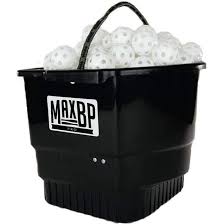Situational hitting is a key component for any successful hitter. Whether it be advancing a runner with a sacrifice bunt or moving a runner over on a ground ball to the right side, knowing the importance of different game situations is  imperative. Today we are going to focus on one of the most exciting aspects of situational hitting - because it leads to a run on the scoreboard and an RBI in the box score - the sacrifice fly.
imperative. Today we are going to focus on one of the most exciting aspects of situational hitting - because it leads to a run on the scoreboard and an RBI in the box score - the sacrifice fly.
To facilitate this drill, a MaxBP machine’s pitch location should be set up in the upper half of the strike zone. The batter should repeatedly focus on hitting fly balls to the outfield by concentrating on full extension of the arms through the baseball. Pitches that are difficult to produce fly balls to the outfield, like balls outside of the strike zone or low strikes, should not be automatic takes for the hitter. In this particular drill, the pupil should act is if they are hitting with less than two strikes. Wait for a pitch to elevate and drive in that runner in scoring position.
This training method is suitable for players ages 13+ and requires a MaxBP machine (or live pitcher), wiffle balls, flat plate and a game bat (or a BetterBat Skinny Barrel Training Bat). This drill is good to do as at least a weekly situational hitting drill; remember to finish with 10 swings with your game bat.
Something to consider, a smart pitcher will want to keep the ball down in the strike zone. So a hitter may have to be patient and work the count, before getting that pitch to elevate. In the case where a player has two strikes, then it’s all about contact and swinging at anything close. This is where the grit and mental toughness of being a ballplayer comes into play, battle that pitcher and find a way to score that baserunner any way you can.
By training in different game situations, a hitter is mentally preparing themselves for a game-like situation. So, when that scenario comes up in a live game, it won’t seem like a foreign concept. By knowing what the pitcher is trying to accomplish (record a strike out or induce a ground ball), a hitter can approach an RBI situation with the confidence of “having a plan” and implementing it successfully. The more the hitter practices that particular situation is usually indicative of how they perform with the game on the line.





















